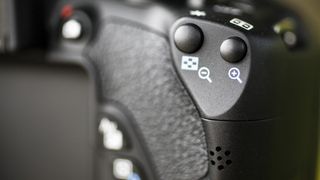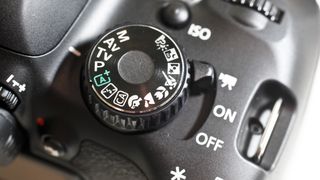Why you can trust TechRadar
Give or take a few millimetres and grams here and there, the Canon EOS 650D is pretty much the same size and weight as the Canon 600D. We are told that the grip is very slightly modified, although we couldn't feel much difference.
We found the Canon EOS 650D comfortable to use, with Canon's usual ergonomic textured grip design. We found the shutter button responsive, whether half-pressing to achieve focus or fully pressing to take a photo. And as we've mentioned, the touchscreen is responsive and fast to use.
The buttons and dials on the Canon 650D have had a few minor tweaks since the Canon 600D. The ISO button, for example, has a nipple that makes it easier to identify when the camera is held to your eye.

Perhaps the biggest change is that the On/Off switch has a third setting - Movie mode. To record videos you still need to press the Live View/Record button. And the Menu and Info buttons are circular now.
Lenses
As with Canon's other beginner and enthusiast DSLRs, the EF-S 18-55mm f/3.5-5.6 IS II kit lens makes a nice, lightweight option for the Canon EOS 650D that is ideal for novices.
However, combining the camera with the new EF 40mm f/2.8 STM pancake lens makes a very lightweight setup, and it's great fun using this stubby, fast prime lens.
At 40mm, this new lens gives an equivalent focal length of 64mm on an APS-C format camera such as the Canon EOS 650D. This makes it a good choice for photographing portraits and still life subjects, rather than wide, sweeping landscape shots.

STM stands for stepper motor, and the new lenses are specifically designed for use when shooting video, since the autofocusing is smoother and slower than with USM lenses. That said, we found the STM lenses fine for most stills photography, apart from sport, when faster autofocusing may be required.
We found that the Canon EOS 650D also feels nicely balanced with the larger, new EF-S 18-135mm f/3.5-5.6 IS STM lens.
Touchscreen technology
The LCD on the Canon EOS 650D is a touchscreen vari-angle 3-inch (7.7cm) 3:2 Clear View II TFT, with approximately 1040k dots resolution. It's the same device as on the Canon 600D, but it's touch-sensitive.
Being able to move the screen so you can see more easily in bright sunlight (while the camera is still trained on the target) is a great help. It's also handy when shooting low to the ground, or overhead; plus you can take those popular self-portraits everybody puts on Facebook!

It seems that many traditional photographers are quick to dismiss the Canon EOS 650D's touchscreen as an unnecessary gimmick. But we would urge you to try it in your local camera shop.
Like the iPhone and iPad, the Canon EOS 650D's LCD is a capacitive touchscreen, and it therefore requires just a touch rather than a press to function.
Capacitive touchscreens tend to be more responsive than resistive screens, and the Canon EOS 650D's monitor doesn't disappoint. We found it responsive, intuitive and fun to use. It's much more responsive than the touchscreens on Canon's compact cameras such as the Canon IXUS 510 HS.

In any shooting mode, with the information screen visible on the LCD, simply tap the Q icon in the bottom-left of the screen to access a wealth of settings, which you can adjust at a finger's touch. You can do this using the Q button and a combination of various dials and buttons on cameras such as the Canon 550D and 600D, but it's much quicker via the Canon EOS 650D's touchscreen.
Scrolling through images is easier with a touchscreen, although the pinching to zoom in and out is a little fiddly on a 3-inch LCD compared to an iPhone's 3.5-inch display. Once zoomed in, it's easier to survey the whole frame using your finger on screen rather than scrolling up, down, left or right with navigation buttons to find the right spot to check if it's sharp.
The touchscreen really comes into its own when using Live View or recording movies. Because you're looking at the screen anyway, it's logical to touch it to move the focus point, or tap it to adjust settings (the accessible functions are highlighted in white-bordered grey boxes).

We also found that the Touch Shutter feature that triggers the camera to focus and take a shot works very well. Tap the subject or focal point on the screen and the Canon EOS 650D focuses and takes the shot fairly quickly.
Although there is a sensor just above the viewfinder that detects when the camera is held to your eye, so the screen automatically switches off when you shoot looking through the viewfinder if the touchscreen is still activated the sensor doesn't work. This means if you hold the camera to your eye you can mistakenly tweak settings on the touchscreen with your nose. Consequently it's important to touch the on-screen icon to turn off the touch-sensitivity once you have finished making adjustments.

We think if you try the touchscreen you'll learn to love it, but Canon hasn't forgotten that there may be some who really can't get on with it - or who are put off buying the camera because they think they won't. The Canon EOS 650D still has all the usual direct controls, and it's possible to switch off the touch control in the menu.
We found it easiest and quickest to use a combination of dials for some settings (such as cycling through the menu with the top dial, since it was tricky to select smaller on-screen buttons), but then use the touchscreen for quickly swiping images to scroll thorough.

